The tell-tale tail
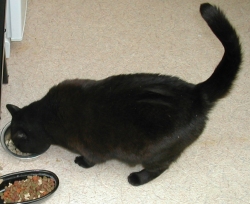
How often have you looked at your cat and thought 'I wonder what's going through her mind?'. As primates, we are trained to look at faces to recognize feelings and moods in others. A slight widening of the eyes, or a twist of the lip can tell us volumes. Unfortunately by this measure, cats are pretty inscrutable. That's not to say you can't find some clues there - for example, droopy whiskers are a sign of an unhappy cat. Whiskers flat against the cheeks means that there's likely to be violence soon, but you'd probably figured that out already from the flattened ears, protruding claws and blood-curdling yowl. Extreme emotion translates well from species to species, but what about more subtle moods?
To learn to read your cat's feelings, its best to leave the face and literally go about things from the other end - the part with the tail on it. Unless you have a Manx or another tail-less breed, the rear end of your cat is the part to consider when you are looking for clues to your furry friend's disposition.
Have you noticed that a cat's tail is almost never still? Even when the cat is apparently asleep, the end may be twitching slightly back and forth. One has to wonder how many calories a cat burns off in the course of a day with all that tail movement, and there you are, ignoring most of what she is trying to tell you with it.
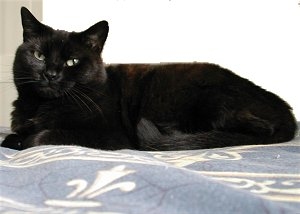
Now notice when your cat steps out of the front door and settles down a few feet outside the house to take stock of her surroundings. The ears are up and attentive, and the tail is wrapped forwards tight against the body, keeping it out of reach of a sudden attack. The cat is relaxed, but cautious. Later, depending on how friendly the environment seems, the cat will let the tail lay full-length behind her, or in really relaxing circumstances, lay full-length while the rest of the cat lies belly-up in the 'vulture-bait position'.
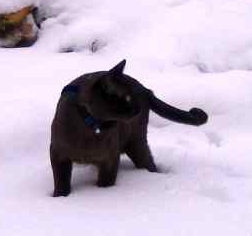
If you think a cat does not try to talk to you with her tail, watch her - for example when she is in the garden - and thinks no-one is observing her. The tail is usually carried like most other animal tails - sticking out,and drooping at about a twenty-degree angle. This is sort of the default position - the tail is not being used to communicate, and the cat has to do something with it, so the tail just hangs there, held high enough to stop it dragging on the ground.
Now step outside, perhaps with a few kitty treats. If the cat's tail goes straight to the vertical as she trots over, this means that she's pleased to see you- or at least pleased to see the kitty treats. A tail absolutely upright and quivering slightly is the feline equivalent of a look of dewy-eyed devotion in a human. If the end of the tail is slightly crooked, this means that the cat is pleased to see you, but is unsure how you feel about meeting her.
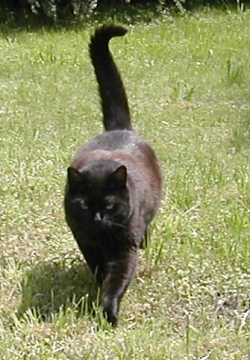
Generally, while you are around, the tail may be upright, but twitching and curling along the last fifth. This signals that your cat is feeling amiable, and is pleased to have you around. Quite often this tail movement accompanies a suggestive movement by the rest of the cat towards the feeding bowl. More rapid twitches mean that the cat is mildly anxious for you to do something, and very rapid twitches signify irritation that you are not doing it.
As a general rule, the more of the tail that is moving, the more agitated your cat is feeling. This does not signal aggression as much as uncertainty, but it is still a danger signal. If you are stroking a cat which is purring and simultaneously slashing her tail back and forth, ignore the purr. Your cat is wondering what to do about this human who won't get out of her face. She is not that keen on clawing the hand that feeds her, but she's not at all keen on being stroked right now either. The tail movement signals her indecision, but it's better to stop stroking before the cat makes up her mind to take action to stop the stroking for herself.
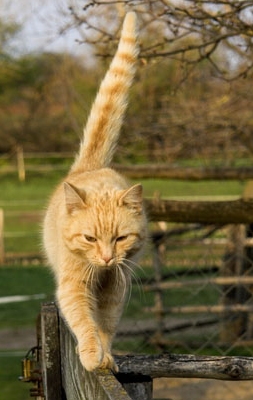
It is because a slashing tail shows indecision that a cat does not do this when about to fight another cat. If the cat has already decided that violence is on the agenda, her upright tail has taken a 'bottle-brush' shape to add to the overall intimidation effect of her appearance. If the tail is puffed out but lowered, the cat is showing she is ready for a confrontation, but does not want one. A tail tucked up under the body signifies defeat, submission, and an extremely unhappy cat.
While you can read a lot from your cat's tail, remember to consider it in connection with the rest of the cat's body language. Quite often the same tail movements can signal aggression or fear. You also need to note what the rest of the cat is doing at the time. For example a cat's tail may twitch from side to side as she walks along the top of a fence, simply because it is helping the cat to keep her balance. Note that as the head turns one way to look at something, the tail moves the other way to preserve equilibrium. In the same way a stalking cat may give her tail a twitch or two just before she pounces, because the tail has a balancing function when she leaps, and the little hunter wants to make sure that her balance is just right.
